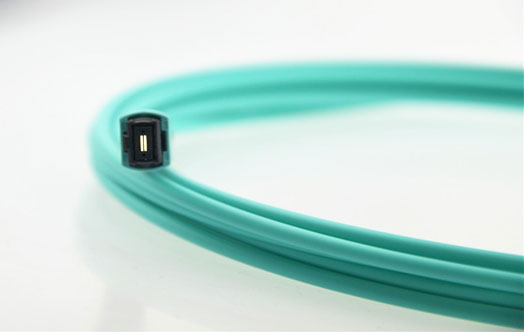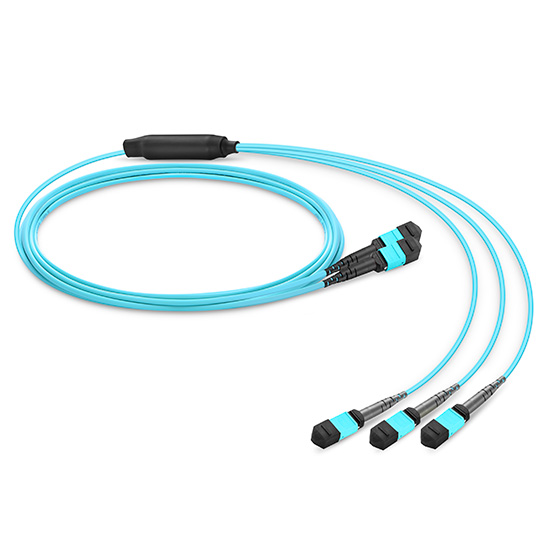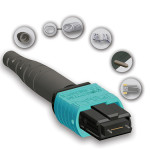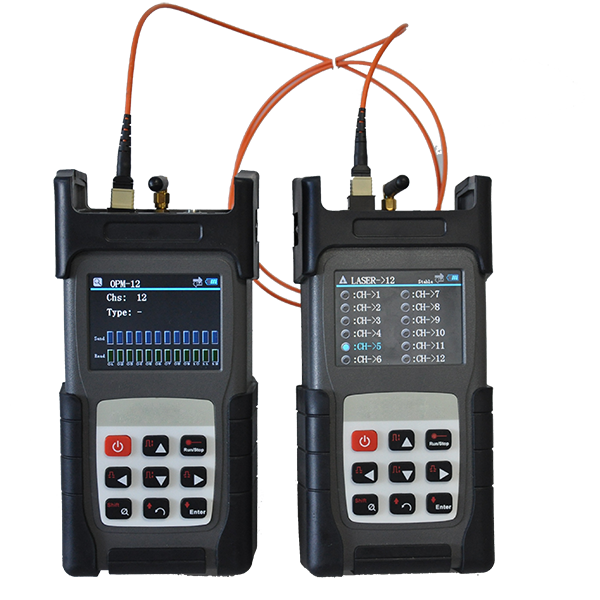Recommended cabling infrastructure deployments in the data center are based on guidance found in TIA-942 Telecommunications Infrastructure Standard for Data Centers. Using a distributed star topology in a structured cabling implementation provides the most flexible and manageable infrastructure. Many data center deployments today use the reduced topology described in TIA-942 where the horizontal distribution areas (HDAs) are collapsed into the main distribution area (MDA). In this collapsed architecture, the cabling is installed between the MDA and the equipment distribution areas (EDAs).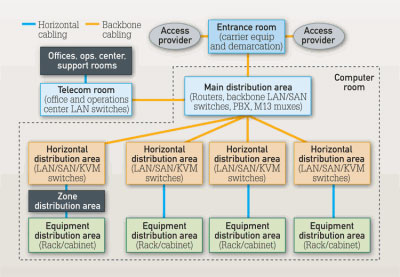
The TIA-942 Telecommunications Infrastructure Standard for Data Centers specifies a topology in which horizontal distribution areas are collapsed into the main distribution area. Within this architecture, the cabling is installed between the main distribution area and the equipment distribution areas.
For optimized performance in meeting data center requirements, the topology of the cabling infrastructure should not be selected alone; infrastructure topology and product solutions must be considered in unison.
Cabling deployed in the data center today must be selected to support data rate applications of the future, such as 100G Ethernet, Fiber Channel ≥32G and InfiniBand ≥40G. To do this, OM3 or OM4 fiber is a must. In addition to being the only multimode fibers included in the 40G and 100G Ethernet standard, OM3 and OM4 fibers provide the highest performance as well as the extended reach often required for structured cabling installations in the data center.
In addition to the performance requirements discussed, the choice in physical connectivity is also important.
Because parallel-optics technology requires data transmission across multiple fibers simultaneously, a multifiber (or array) connector is required. Using MPO-based connectivity in today’s installations provides the means to migrate to this multifiber parallel-optic interface when needed.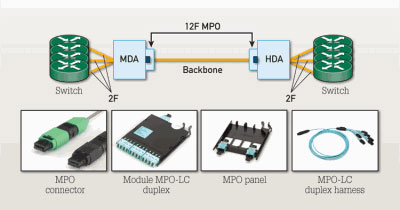
A plug-and-play system incorporating factory-terminated MPO connectivity, as shown here, may include pre-terminated modules, panels and harnesses to meet the needs of serial Ethernet applications.
Factory-terminated MPO solutions allow connectivity to be achieved through a simple plug-and-play system. To meet the needs of today’s serial Ethernet applications, MPO-terminated backbone/horizontal cabling is simply installed into pre-terminated modules, panels or harnesses.
Cabling migration from 10G to 40G to 100G in an MPO-based system is a simple and easy deployment. Starting with 10G, a 12-fiber MPO cable is deployed between the two 10G switches. Modules are used at the end to transition from the 12-fiber MPO to LC duplex. This enables connectivity into the switch.
When the switches migrate to 40G, the module is removed and is replaced by a 12-fiber MPO adapter panel. The use of a 12-fiber MPO jumper is needed to establish connectivity between the switches.
Future 100G networks will require a 24-fiber MPO jumper to establish a link. Systems that use 12-fiber MPO backbone cabling will need a 24-fiber or two 12-fiber MPO jumpers.
Multiple loss-performance tiers are available for MPO connectivity solutions. Just as connector loss must be considered with current, deployed applications such as 10G Ethernet, insertion loss is also a critical factor for 40G and 100G Ethernet applications. For example, IEEE 802.3ae defines a maximum distance of 300 meters on OM3 multimode fiber for 10G Ethernet (10GBase-SR). To achieve this distance, a total link loss of 2.6 dB is needed with a maximum total connector loss of 1.5 dB. As the total connector loss in the channel increases above 1.5 dB, the supportable distance decreases the channel loss increases. When extended distances or multiple connector matings are required, low-loss performance modules and connectivity may be necessary. OM3 is bandwidth-limited beyond 300 meters.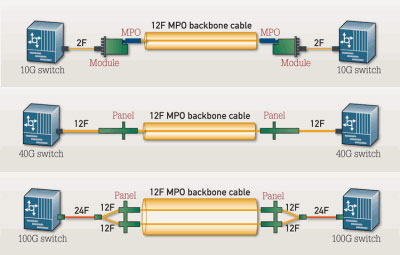
Cabling migration from 10- to 40- and 100-Gbit/sec transmission can be achieved with an MPO-based optical connectivity system, as shown here.
Likewise, with the total connector loss for 40G and 100G Ethernet, similar considerations must be evaluated. MPO connector matings with maximum connector loss specifications of 0.5 dB and 0.35 dB provide alternatives for variations in the infrastructure design as the physical connectivity and channel distance are taken into account to make a final selection in product performance.
Link-loss migration from 10G to 40G and 100G in an MPO-based system is a simple and easy deployment.
In the illustrated example, two 50-meter links are connected from the MDA to the HDA. 10G switches are deployed, and the link loss is calculated from the HDA to the MDA and from one HDA to another. In this case, both links are below the 2.6-dB maximum for 10G.
As the network migrates to 40G, the link-loss requirements get tighter. In this example, two 50-meter links are connected from the MDA to the HDA. 40G switches are deployed, and the link loss is calculated from the HDA to the MDA and from one HDA to another. In this case, the losses of both links are below the 1.9-dB maximum for 40G on OM3 fiber.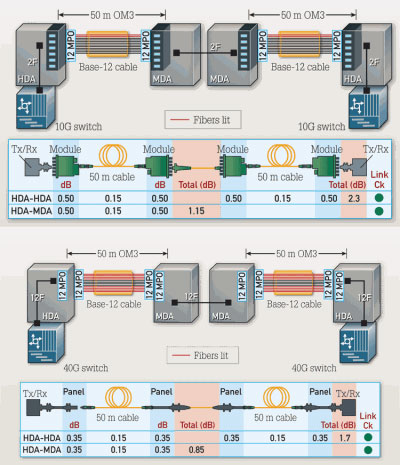
These schematics show 10-, 40- and 100-Gbit transmission links set up between a data center’s main distribution area and horizontal distribution area. In each case, the MPO-connector-based fiber-optic systems met the required loss budgets for their respective transmission speeds.
As the network migrates to 100G, the link-loss requirements are the same as 40G. In this scenario, two 50-meter links are connected from the MDA to the HDA. 100G switches are deployed, and the link loss is calculated from the HDA to the MDA and from one HDA to another. In this case, both links are below the 1.9-dB maximum for 100G on OM3 fiber.
To best meet the needs of the future, MPO-based connectivity using OM3 and OM4 fiber is the ideal solution in the data center. With inherent modularity and optimization for a flexible, TIA-942-compliant structured cabling installation, MPO-based optical fiber systems can be installed for use in today’s applications, while providing an easy migration path to future high-speed technologies such as 40G and 100G Ethernet.
Source from: DAVID KOZISCHEK AND DOUG COLEMAN, CORNING CABLE SYSTEMS
